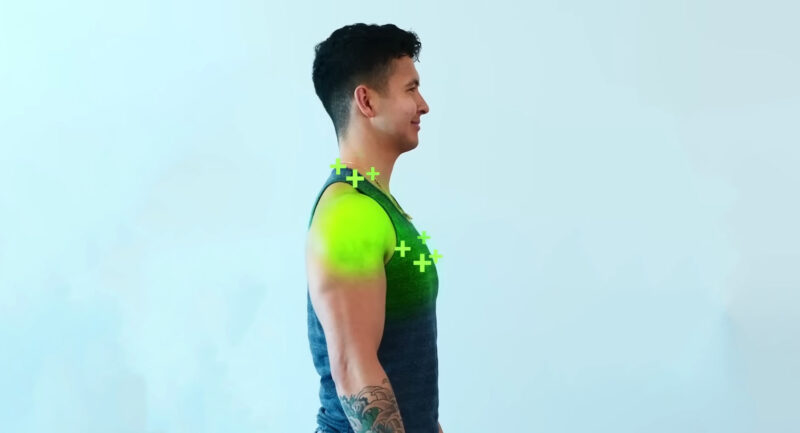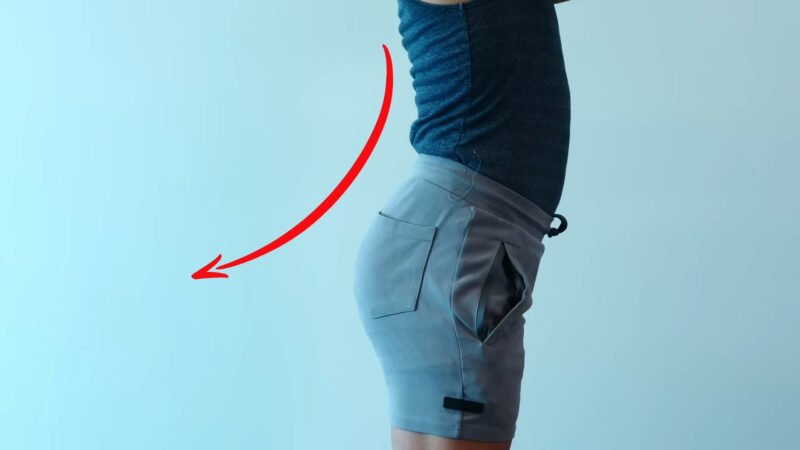Have you ever had someone tell you to “sit up straight”? I know I sure have, but keeping perfect posture all the time is no joke! Our posture is usually just a result of how we live – like sitting at school desks for hours or playing sports. But don’t stress, Exercises to improve posture can totally help improve it!
Stance is basically just how your body is aligned when you’re chilling or moving. Good posture means having a nice straight spine, even muscle use, and joints in the right spot. This helps you move better, prevents aches and pains, and protects your body from damage over time.
So what does the perfect posture look like?

It’s not one exact position, but generally, you want your head centered over your shoulders, shoulders over hips, and hips over ankles. Your neck, back muscles, and hips play a big role in that.
What Causes Bad Posture?
Sometimes it’s things out of your control, like genetics or injuries. But usually, it’s because of how you spend your days. Things like slouching when you sit, carrying heavy backpacks lopsided, and staring at screens for hours can all contribute to poor posture.
Even your workouts might be a problem if you do the same moves over and over or only train some muscles. Stress can also make your muscles tight, which affects posture.Do exercises to improve posture? But first, you gotta figure out what’s causing your issue. Since bad posture is often due to weak, tight, or unbalanced muscles, exercises that strengthen and stretch can help restore balance. Workouts that do both at the same time, like yoga, Pilates, and mobility routines, are really good for encouraging that balance.
Give some of those a try and see if it doesn’t help straighten you out! Let me know if any part doesn’t make sense. To enhance your posture, focus on strengthening your core, back, and shoulder muscles and stretching your chest, hamstrings, and hip flexors.
Here are 12 Exercises to improve posture and stretches that always helped me in the past:
12. Quadruped Chin Tuck with Scapular Push-up
- Start on your hands and knees, tuck your chin, and lower your chest between your shoulders.
- Press into your palms and lift your upper back.
- Repeat for 10-30 seconds, and do 3-5 sets.
- Works your deep neck stabilizers and serratus anterior.
11. Seated Band Pull-Apart
- Sit with your feet flat on the floor, holding a resistance band at belly button height.
- Squeeze your shoulder blades together and pull the band apart.
- Do two to three sets of 15-20 reps.
- Works your upper back muscles.
10. Dead Bug Variation
Dead bug exercise variations are one of our absolute favorite exercises when done properly with advanced progressions, they can be a core killer!! Learning to activate your deep spinal stabilizers like the transversus abdominis in these positions is a stepping stone for progressing to more dynamic exercises.
As with all “core stabilization” exercises, you must progress them to more functional and upright movements once you learn what it feels like to truly stabilize your spine!
- Lie on your back with your arms extended and knees bent at 90 degrees.
- Press your right palm into your left thigh and extend your right leg and left arm.
- Do 10-15 reps on each side, do 2-3 sets.
- Works your hip flexors and core.
9. Single-leg Glute Bridge with Knee Drive
- Lie on your back with your knees bent and feet flat on the floor.
- Lift your hips into a bridge and draw one knee toward your chest.
- Hold for 10-30 seconds, do two to three sets.
- Works your glutes, hip flexors, hamstrings, and core.
The single-leg bridge can yield sufficient gluteus maximus and gluteus medius muscle activity for strengthening without external loading and thereby provide individuals a means to safely and conveniently increase hip joint stability.
8. Superman
This is a great exercise for stretching the lower back, upper back, and shoulders.
How To Do The Move
- Lie flat on your stomach with your arms straight out in front of you.
- Raise your arms and feet off the floor, keeping your core flat on the ground.
- Hold the raised position for three seconds and then lower your arms and feet back to the floor. Now that you know the superman, add it to your workout arsenal and strengthen your upper back and lower back while toning your glutes.
7. Prone IYTWO Series
- Lie face-down with your arms and legs extended.
- Lift your arms into different positions (I, Y, T, W, O) while keeping your core engaged.
- Do two to four reps of each position.
- Works your upper back and shoulders.
| Step: | Explanation |
|---|---|
| 1. | Starting Position: Lie on your stomach on a mat, with your arms outstretched overhead palms facing one another and your legs outstretched behind you with your toes pointed toward the wall behind you. Engage your abdominal muscles to stabilize your spine. Pull your shoulder blades back and down. Align your head with your upper spine. Keep these engagements throughout the exercise. |
| 2. | “I” Formation: Gently exhale and slowly lift your arms off the floor, with palms facing inward. Keep your head aligned with your upper spine. Focus on lifting from the shoulders and not the low back. Hold this position for 5 – 10 seconds then relax and return to your starting position. Perform 2 – 4 repetitions. |
| 3. | “Y” Formation: From the same starting position, gently exhale and slowly lift your arms off the floor, moving your arms into the “Y” formation as illustrated with palms facing inward. Keep your head aligned with your upper spine. Focus on lifting from the shoulders and not the low back. Hold this position for 5 – 10 seconds then relax and return to your starting position. Perform 2 – 4 repetitions. |
| 4. | “T” Formation: From the same starting position, gently exhale and slowly lift your arms off the floor, moving your arms into the “T” formation as illustrated with palms facing forward. Keep your head aligned with your upper spine. Focus on lifting from the shoulders and not the low back. Hold this position for 5 – 10 seconds then relax and return to your starting position. Perform 2 – 4 repetitions. |
| 5. | “W” Formation: From the same starting position, gently exhale and slowly lift your arms off the floor. Bend your elbows and pull them toward your waist, forming the letter “W” as illustrated Palms face inward. Keep your head aligned with your upper spine. Focus on lifting from the shoulders and not the low back. Hold this position for 5 – 10 seconds then relax and return to your starting position. Perform 2 – 4 repetitions. |
| 6. | “O” Formation: Start with your arms down by your sides. Gently exhale. Lift your arms off of the floor. Rotate your arms inward in order to bring your hands together on your back. Stack your hands in the small of your back so that your arms create an “O” shape. Keep your head aligned with your upper spine. Focus on lifting from the shoulders and not the low back. Hold this position for 5 – 10 seconds then relax and return to your starting position. Perform 2 – 4 repetitions. |
6. Bird-Dog
- Start in a quadruped position with hands under shoulders and knees under hips.
- Extend one leg behind you and the opposite arm in front of you, both straight and parallel to the floor.
- OPTIONAL: For more challenges, bring your elbow to meet your knee and then extend back out.
- Do 5-15 reps on each side.
- This exercise targets your abs and is also a great warm-up.
5. Neck Stretch
- Stand with your feet hip-width apart,
- Slowly draw your ear toward your shoulder,
- Hold for 5-10 seconds, then switch sides.
- Do two to four reps on each side.
- Works your neck and upper back.
People who benefit from cervical traction often have an instant improvement in their neck pain after a few treatments.
Of all the Exercises to improve posture, this is one of the best because it reduces pain. Reduced stiffness and tension in your neck muscles.
4. Leg Crossover Stretch
- Lie on your back with your knees bent and feet flat on the floor.
- Cross one leg over the other and rotate your hips to the side.
- Hold for 15-30 seconds, do two to four reps on each side.
- Works your glutes, hips, quads, and lower back.
Benefits
- Relieves stiffness and discomfort in the spine, (neck, back, and shoulders), and the hips and knees.
- Helps reduce pelvic floor muscle tightness and discomfort.
- Eases symptoms of plantar fasciitis, ankle pain, and iliotibial band discomfort.
- Keeps hip muscles strong and flexible to make it easier to perform sporting activities, lunges, squats, bending, lifting, getting in and out of a vehicle standing up/sitting down, turning, and changing directions.
3. Supine Hamstrings Stretch
- Lie on your back with one leg extended toward the ceiling.
- Flex your toes toward your body and hold for 15-30 seconds.
- Do two to four reps on each side.
People often are confused about how to lose tight hamstrings. The answer is simply – Works your hamstrings.
- Lie flat on the ground or on a mat with the legs stretched out.
- To stretch the right leg, hold the back of the right knee with both hands, pull it up toward the chest, and slowly straighten the knee until it feels like it is stretching.
- Hold the stretch for 10–30 seconds.
- Repeat 2–3 times on each leg.
2. Kneeling Hip-flexor Stretch
- Start in a half-kneeling position, and gently lean forward into your front hip.
- Hold for 30-45 seconds, do 2-5 reps on each side.
- Works your hip flexors.
This is the best way to stretch for hip flexor.
1. The greatest of all Exercises to improve posture
THE PLANK!
- Start on your hands and knees and extend your legs, balancing on your toes.
- Keep your neck long and core engaged.
- Works your core, shoulders, back, glutes, and quads.
On average, a beginner should aim to hold a plank for 15 to 30 seconds. If you are not a beginner, try three sets of up to 60 seconds.
This pose helps to build abdominal muscles and in many cases even boosts the development of muscles in other parts of the body (due to added core strength). With more muscle mass, you will burn more calories and this will regulate a healthy appetite.
Summary
Exercises to improve posture we talked about are super helpful for improving your posture over time. Give them a try a few times a week – you’ll start to feel a difference! Remember, posture is all about balance. You gotta strengthen weak areas like your upper back and core, while also loosening up tight spots in your shoulders and hips.
Staying active will keep your body in line and prevent future aches. Let me know if any of the moves don’t make sense or if you have other questions!

